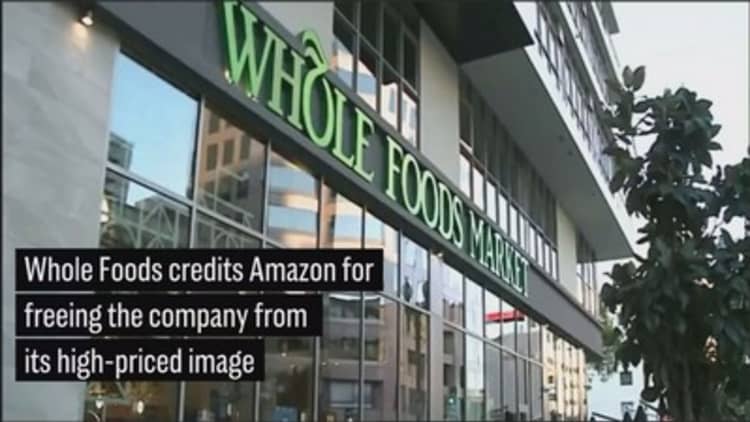Here's one unique way to keep an eye on Whole Foods' business since the grocer was scooped up by Amazon: monitor the number of cars in its parking lots.
Whole Foods' parking lots were fuller in September, JPMorgan reported, based on an analysis of satellite data provided by Orbital Insight. The acquisition of the organic grocery retailer was official starting Aug. 28.
For the month of September, car traffic at Whole Foods stores was up 4.6 percent, the biggest increase since June 2014.
To be sure, JPMorgan analyst Ken Goldman explained in a Wednesday note to clients that car traffic was "perhaps not as high as some observers may have expected."
A two-year stacked number has been falling since July. Car traffic on a two-year stacked basis is computed by adding the number of cars from the period referenced, for example, September 2017, to that of the same period one year ago.
In this case, car traffic at Whole Foods in September 2016 was down nearly 10 percent, dragging the latest two-year stacked number down. At the time, Whole Foods was struggling to grow same-store sales as it bounced back from being accused of price gouging.
Whole Foods' car traffic year over year
Source: Orbital Insight and JPMorgan
At Kroger, which has taken a beating by investors in the aftermath of the Amazon-Whole Foods deal, car traffic dropped significantly in September, JPMorgan said. Satellite data showed a 7.3 percent decrease during the month. On a two-year stacked basis, the drop was even more significant, at 9.8 percent.
This suggests Kroger's same-store sales will be down 0.8 percent in the third quarter, much lower than what analysts have been anticipating, Goldman added.
Kroger shares dove last month, after the grocer's second-quarter profit slid nearly 8 percent as it slashed prices amid growing competition in the sector. Kroger has meantime said it expects same-store sales growth, excluding fuel, of 0.5 to 1 percent for the remainder of the fiscal year.
Kroger and Whole Foods declined to comment.
A spike in Whole Foods' car traffic can be attributed much to the fact that Amazon promised price cuts throughout stores, starting as soon as Aug. 28. And Whole Foods has been known for its "whole paycheck" image, so the discounts have been a welcome change for many shoppers.
A study by location intelligence company Foursquare found a 25 percent increase in foot traffic at Whole Foods stores over the first two days that the company was owned by Amazon.
Since then, though, traffic has dropped off, Foursquare told CNBC in a follow-up study. In its second week under Amazon's wings, from Sept. 4 to Sept. 10, traffic was only up about 8 percent when compared with an average week in August 2017.
WATCH: Whole Foods CEO says Amazon helped it escape high-priced image



